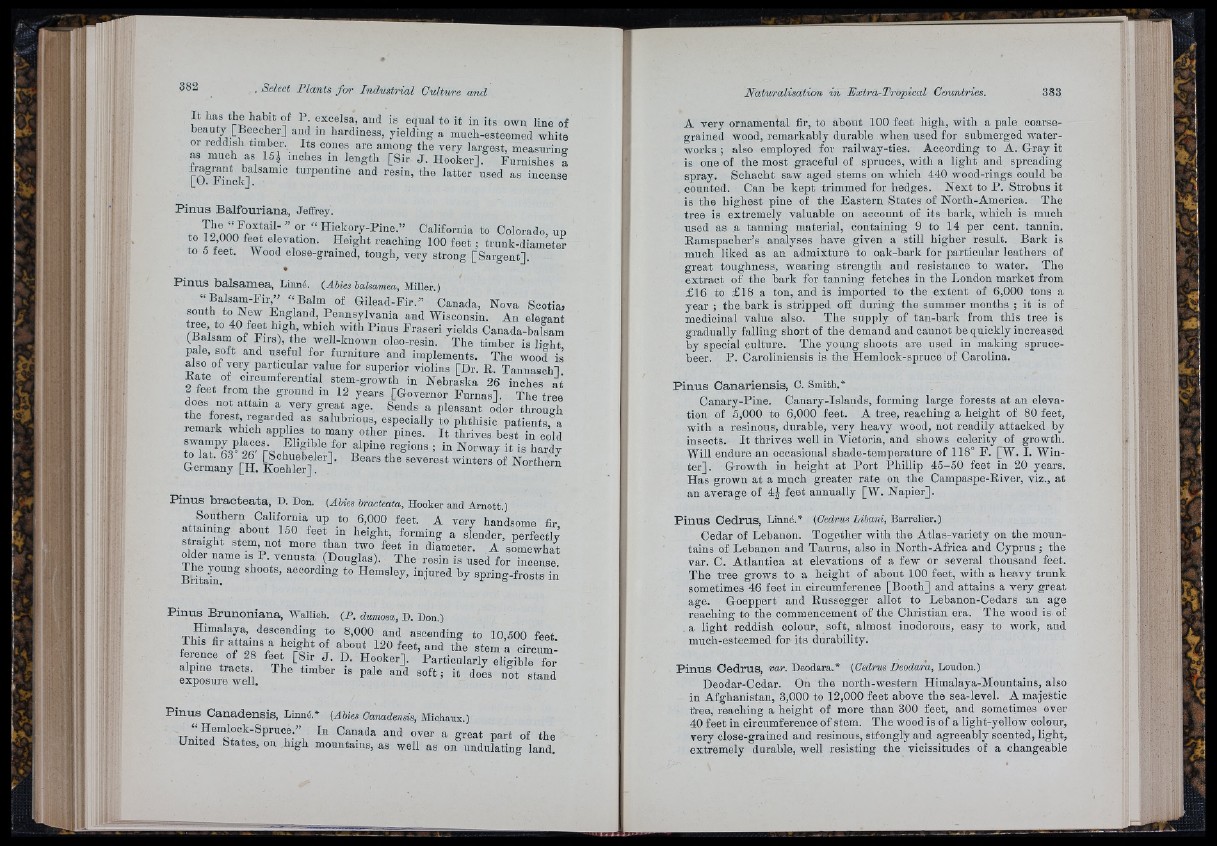
Lui
y: -A
I t has the habit of P excelsa, and is equal to it in its own line of
beauty [Beecher] and in hardiness, yielding a much-esteemed white
or reddish timber. ^ Its cones are among the very largest, measuring
as much as 15J mches in length [S ir J . Hooker]. Furnishes f
fragrant balsamic turpentine and resin, the latter used as incense
|_U. 4 incKj.
P in u s B a lfo u ria n a , Jeffrey.
r T o n # # ' " “ Hickory-Pine.” California to Colorado, up
to U 000 feet elevation. Height reaching 100 feet ; trimk-diameter
to 5 feet. Wood close-grained, tough, very strong [Sargent].
•
P in u s b a ls am e a , Linné. (^Ahîes halsamea, Miller.)
“ Balsam-Fir7 “ Balm of Gilead-Fir.” Canada, Nova Scotia,
t T + Wisconsin. An elegant
tree to 40 feet high which with Pinus Fraseri yields Canada-balsam
(Balsam of Firs), the well-known oleo-resin. The timber is light
pale, soft and useful for furniture aud implements. The wood is
also of very particular value for superior violins [Dr. E. Tannasch].
Bate of circumferential stem-growth in Nebraska 26 inches ¿ t
2 teet trom the ground in 12 years [Governor Furnas]. The tree
does not attain a very great age. Sends a pleasant odor through
the foiest regarded as salubrious, especially to phthisic patients, a
remark wliioli applies to many other pines. I t thrives best in cold
Germany [H. to e Ï T ] !® '^ ’
P in u s b r a c te a ta , D. Don. {Abies hracteata, Hooker and Arnott.)
Southern California up to 6,000 feet. A very handsome fir,
straight S/te m, no1t more th7a“n two feet in diameter. A sopmerefewchtlayt
older name is P. venusta (Douglas). The resin is used for incense.
Briteffi"“ ^ according to Hemsley, injured by spring-frosts in
P in u s B ru n o n ia n a , Wallich. (P. dumosa, D. Don.)
Himalaya, descending to 8,000 aud ascending to 10,500 feet
This fir attains a height of about 120 feet, and the stem a ciroum!
ferenoe of 28 feet [Sir J . D. Hooker]. Particularly eligible for
P in u s C a n ad e n sis , Linné.* {Ahies Canadensis, Michaux.)
part of the
United States, on high mountains, as well as on undulating land.
A very ornamental fir, to about 100 feet high, with a pale coarsegrained
wood, remarkably durable when used for submerged waterworks
; also employed for railway-ties. According to A. Gray it
is one of the most graceful of spruces, with a light and spreading
spray. Schacht saw aged stems on which 440 wood-rings could be
counted. Can he kept trimmed for hedges. Nex t to P . Strobus it
is the highest pine of the Eastern States of North-America. The
tree is extremely valuable on account of its bark, which is much
used as a tanning material, containing 9 to 14 per cent, tannin.
Ramspacher’s analyses have given a still higher result. Bark is
much liked as an admixture to oak-hark for particular leathers of
great toughness, wearing strength and resistance to water. The
extract o f the hark for tanning fetches in the London market from
£16 to £18 a ton, and is imported to the extent of 6,000 tons a
year ; the bark is stripped oS during the summer months ; it is of
medicinal value also. The supply of tan-bark from this tree is
gradually falling short of the demand aud cannot be quickly increased
by special culture. The young shoots are used in making spruce-
heer. P . Caroliniensis is the Hemlock-spruce of Carolina.
P in u s C a n a rie n s is , C. Smith.*
Canary-Pine. Canary-Islands, forming large forests at an elevation
of 5,000 to 6,000 feet. A tree, reaching a height of 80 feet,
with a resinous, durable, very heavy wood, not readily attacked by
insects. I t thrives well in Victoria, and shows celerity of growth.
Will endure an occasional shade-temperature of 118° F. [W. I. Winte
r]. Growth in height at P o rt Phillip 45-50 feet in 20 years.
Has grown a t a much greater rate on the Campaspe-Eiver, viz., at
an average of 4J feet annually [W. Napier].
P in u s C ed ru s, Linné.* {Cedrus Lihani, Barrelier.)
Cedar of Lebanon. Together with the Atlas-variety on the mountains
of Lebanon and Taurus, also in North-Africa and Cyprus ; the
var. C. Atlantica a t elevations of a few or several thousand feet.
The tree grows to a height of about 100 feet, with a heavy trunk
sometimes 46 feet in circumference [Booth] and attains a very great
age. Goeppert and Russegger allot to Lebanon-Cedars an age
reaching to the commencement of the Christian era. The wood is of
a light reddish colour, soft, almost inodorous, easy to work, aud
much-esteemed for its durability.
P in u s C e d ru s, var. Deodara.* {Gedrus Deodara, Loudon.)
Deodar-Cedar. On the north-western Himalaya-Mountains, also
in Afghanistan, 3,000 to 12,000 feet above the sea-level. A majestic
free, reaching a height of more than 300 feet, and sometimes over
40 feet in circumference of stem. The wood is of a light-yellow colour,
very close-grained and resinous, stfongly and agreeably scented, light,
extremely durable, well resisting the vicissitudes of a changeable